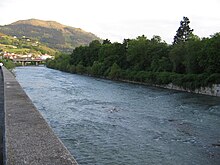Oria River
| Oria | |
|---|---|

The Oria river on its way through Lasarte-Oria with mount Buruntza in the background
|
|
| Country | Spain |
| Physical characteristics | |
| Main source | Basque Mountains |
| River mouth | Cantabrian Sea (Bay of Biscay) |
| Length | 75 km (47 mi) |
| Discharge |
|
| Basin features | |
| Basin size | 882.5 km2 (340.7 sq mi) |
The Oria [ˈoɾja] is a river in the Basque Country at the north of the Iberian Peninsula. It's one of a series of Basque rivers flowing into the Bay of Biscay (Atlantic basin) and the main river of the province Gipuzkoa in volume (25.6 m3/s), length (75 km) and basin (882.5 km2), the main feature of these rivers aligned south to north being their shortness. The maximum elevation at the source is 1,260 m, while at its lowest height the tidal influence extends inland up to Usurbil (estuary). On this final stretch, many marsh and wetland strips dotted the banks of the Oria, although some of them have been drained for agricultural and building purposes.
The river rises at the south of the municipality of Zegama near the hamlet of Otzaurte and the San Adrian tunnel, harvesting the waters of the north-eastern side of the mountain range Aizkorri, so the river results from the merging of several streams. The first town it crosses is the very nucleus of Zegama, with other major towns of Gipuzkoa being located on the river, e.g. Beasain, Ordizia, Tolosa, Andoain, Lasarte-Oria, Usurbil and finally Orio at the mouth. From Lasarte-Oria to Orio, the sinuous and traffic laden coastal road N-634 winds along.
The Oria is a central river and an important axis for the province of Gipuzkoa. The major road A-1 (European route E-5 E-80) runs along the Oria most of the time, as well as the Spanish Northern Railway, right from its rise on the slopes of Aizkorri. Its watershed holds a population of 128,000 inhabitants, most of the lowland being heavily inhabited, while the area of its southernmost stretch is sparsely populated.
...
Wikipedia
